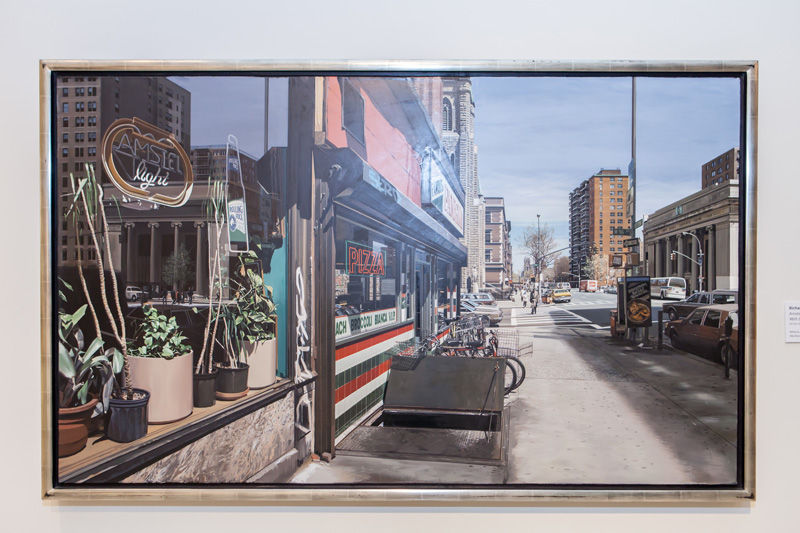Maybe it was end-of-season homesickness, or one too many Florida sunrises. Whatever the reason, on Wednesday night, members of Vero Beach Museum of Art’s Athena Society stood in front of Richard Estes’ “Amsterdam Avenue and 96th Street” and pined for New York City.
Something in the hyper-realistic street scene spoke to them in its ordinariness, house plants grabbing light through plate glass, bikes with oversized baskets parked out front, neon signs turned off for the day – Estes loved to paint scenes of Sundays.
What they won’t have to remember is the painting itself: it is now part of the permanent collection. On loan for the event, the 36-by 60-inch oil painted in 1995 was purchased by the group after spirited debate and secret balloting, the results read following an elegant dinner in the Holmes Great Hall.
Roseanne Diserio, a John’s Island resident since the 1980s, once worked as director of development for the Silvermine Guild Center for the Arts in New Canaan, CT.
“It’s strange,” she began, trying to address why so many people were struck by the Estes. “I mean, we’re looking at buildings and sidewalks. It has a feeling. You get a feeling of New York. It really talks to you and impacts you. I think a picture, to be really good, has to talk to you somehow.”
Asked if the Estes made her nostalgic about the city, Diserio said, “I spent time there, but I didn’t particularly like it. The painting is good because it gives you a real feeling.”
Diserio came to the Athena dinner with Jacqueline Malloy, who was on the board of the museum for seven years. She arrived in Vero Beach 20 years ago from Rome, Italy, where she lived for 18 years “for the art,” she says. She was determined to retire to a town with a museum. Malloy is a veteran of the Athena events. “You get more discussion now because not everybody has the same tastes,” she says.
The street scene was chosen from among six paintings selected by the museum administration for the Athena Society’s one-night shopping spree; all were deemed important prospective additions to the collection, which focuses on 20th and 21st century American art.
The Athena Society is formed of museum supporters who up their already top-level memberships by $5000 to be a part of the society, which also has its own lecturers and travel opportunities to visit top museums as well as private collections.
Other paintings in competition with the Estes were “Two Figures,” a large Elmer Bischoff painting of two nudes that could not be shipped from its home in California and instead was represented by a smaller photo with black corners on the wall showing its true size; “Perkins Cove Fish Houses, Ogunquit, Maine,” by Niles Spencer in 1926, its angular buildings showing the influence of Cezanne on his architectural landscapes; a 1918 still life called “Tulips” by Arthur Beecher Carles, the American modernist; and a pair of small cubist paintings by different artists, Suzy Frelinghuysen and George L.K. Morris. A sixth option, which has been exercised once before, was to roll over the funds to next year.
Estes, a living painter who studied at the School of the Art Institute of Chicago, is best known for work embodying photorealism, and he was a founder of that school of painting along with Chuck Close and Duane Hanson. His 1968 work “Telephone Booths” is among his most famous.
As for the chairman of the Athena dinner, Carol Coxhead, she thought the Estes was “gorgeous,” but she was rooting for the Bischoff nudes. ‘We have a place in San Francisco, which is one reason I want to pick up on that.”
Coxhead pointed out that there are now 86 members of the Athena Society, with a 95 percent retention rate one year to the next. Who could stand to let go of that potentially deciding vote, after all? “People don’t drop out. We’re a young museum and this shows the vitality of the energy for the museum.”
Asked whether she cared how the vote came out, Coxhead drew back. “Of course I care,” she said. Then in an instant, the rivalry was dispelled. “I mean, no,” she started again. “We have great choices.
It’s the most fun thing of the year. We get to buy at piece of art for $400,000 or $500,000. It’s like going shopping with someone else’s money. Is that not fun?” she asked.

